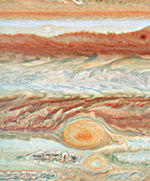File:Three Red Spots Mix it Up on Jupiter.jpg

Size of this preview: 800 × 374 pixels. Other resolutions: 320 × 149 pixels | 1,000 × 467 pixels.
Original file (1,000 × 467 pixels, file size: 476 KB, MIME type: image/jpeg)
File history
Click on a date/time to view the file as it appeared at that time.
| Date/Time | Thumbnail | Dimensions | User | Comment | |
|---|---|---|---|---|---|
| current | 20:06, 9 August 2008 |  | 1,000 × 467 (476 KB) | Friendlystar | {{Information |Description={{en|1=This sequence of Hubble Space Telescope images offers an unprecedented view of a planetary game of Pac-Man among three red spots clustered together in Jupiter's atmosphere. The time series shows the passage of the "Red S |
File usage
The following pages on the English Wikipedia use this file (pages on other projects are not listed):
Global file usage
The following other wikis use this file:
- Usage on ca.wikipedia.org
- Usage on de.wikipedia.org
- Usage on fr.wikipedia.org
- Usage on it.wikipedia.org
- Usage on ja.wikipedia.org
- Usage on no.wikipedia.org
- Usage on pt.wikipedia.org
- Usage on ru.wikipedia.org
- Usage on uk.wikipedia.org
- Usage on vi.wikipedia.org
- Usage on www.wikidata.org
- Usage on zh.wikipedia.org





